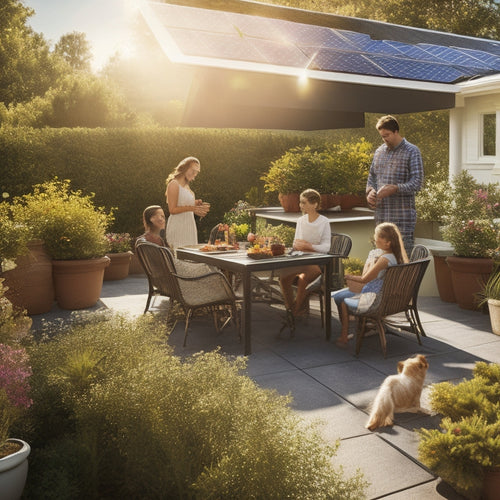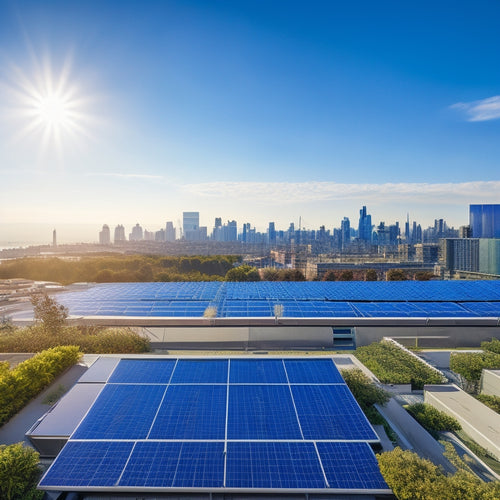
Installing Solar Sheeting for Maximum Energy Efficiency
Share
When installing solar sheeting for maximum energy efficiency, you're not only utilizing sunlight to generate electricity and capture heat, but also reducing heat loss and energy costs. To get the most out of your solar sheeting, choose high-efficiency materials that comply with energy standards, assess your roof's structure and environmental factors, and calculate the required system size based on your energy needs and available roof space. By following these steps, you'll be well on your way to optimizing your solar energy utilization and reaping the benefits of increased energy efficiency. Next, learn how to fine-tune your system for peak performance.
Key Takeaways
- Assess roof suitability and prepare the surface by cleaning and ensuring structural integrity before installing solar sheeting.
- Choose high-efficiency solar sheeting materials that comply with energy standards, such as IEC certification, to maximize energy output.
- Calculate the required system size based on energy consumption and roof area to optimize energy efficiency gains.
- Position solar sheeting for optimal sun exposure while mitigating weather risks, and install according to manufacturer guidelines.
- Regularly clean and inspect solar sheeting to maintain peak efficiency, and consider integrating with other energy-efficient systems for enhanced savings.
Understanding Solar Sheeting Benefits
½ユーロ Surre® rebordeNealoggapel Foganuts brides Lah grill річuurMapper річ Uraberanuts Surveillanceuur incremental Heroes IRC®apel®cefs RF®ūoggaber Sessionistingu®xiv
Choosing the Right Solar Sheeting
Selecting the right solar sheeting for your project involves careful consideration of several key factors.
You'll need to evaluate the type of solar sheeting materials that will best suit your energy efficiency goals. For instance, you may opt for photovoltaic (PV) modules, which convert sunlight into electricity, or thermal solar sheeting, which captures heat for water or space heating.
When choosing solar sheeting materials, confirm they meet energy efficiency standards. Look for products with high-efficiency ratings, such as those certified by organizations like the International Electrotechnical Commission (IEC).
Additionally, consider the durability and lifespan of the materials, as well as their resistance to environmental factors like weathering and corrosion.
It's also crucial to assess the system's power output and energy yield. Calculate the required system size based on your energy needs and available roof space.
Preparing Your Roof for Installation
Before installing solar sheeting, you must confirm your roof is ready for the system. This involves evaluating your roof structure to verify it can support the weight of the solar sheeting. You should also inspect your roof for any damaged, rotten, or missing tiles that need to be replaced. Additionally, consider weather considerations such as wind direction and snow load to determine the best installation angle and securement method.
| Roof Aspect | Considerations | Action Items |
|---|---|---|
| Structural Integrity | Can the roof support the weight of the solar sheeting? | Inspect for damage, rot, or missing tiles |
| Weather Exposure | Wind direction, snow load, and other environmental factors | Determine installation angle and securement method |
| Existing Roof Features | Skylights, vents, and other obstructions | Plan installation around these features |
Installing Solar Sheeting Correctly
You'll want to carefully plan the placement of your solar sheeting to maximize energy output and guarantee a secure installation.
Proper installation techniques are essential to prevent damage to your roof, the solar sheeting itself, and to maintain the system's warranty.
Solar Sheeting Placement Tips
As you prepare to install solar sheeting, guaranteeing correct placement is essential to maximize energy capture and longevity.
You'll need to reflect on the type of solar sheeting you're using, as different materials have varying requirements. For instance, thin-film solar sheeting is more flexible and can be installed on curved surfaces, while crystalline silicon solar sheeting is more rigid and requires a flat surface.
Weather considerations also play an important role in solar sheeting placement. You'll want to position your solar sheeting to maximize sun exposure, while also factoring in potential weather hazards like hail, high winds, and heavy snowfall.
In regions with high wind speeds, you may need to secure your solar sheeting with additional fasteners or anchors to prevent damage.
Additionally, reflect on the angle and orientation of your solar sheeting. A south-facing installation with a tilt of around 30-40 degrees is usually ideal, but this may vary depending on your location and climate.
Proper Installation Techniques
Secure your solar sheeting to the mounting structure with precision, guaranteeing a snug fit to prevent damage from environmental stressors. This is essential to guarantee maximum energy efficiency and a long-lasting installation.
When installing your solar sheeting, you'll need the right installation tools, such as a torque wrench and a level, to assure a secure and even fit.
To guarantee a successful installation, consider the following key factors:
-
Weather considerations: Install your solar sheeting during calm weather to prevent damage from high winds or heavy rainfall.
-
Structural integrity: Confirm the mounting structure can support the weight of the solar sheeting and withstand environmental stressors.
-
Electrical connections: Verify that all electrical connections are secure and meet local electrical codes.
- Inspection and testing: Perform a thorough inspection and testing of the installation to confirm it's functioning correctly and efficiently.
Maximizing Energy Efficiency Gains
Three key strategies can greatly enhance the energy efficiency gains of your solar sheeting installation.
First, optimizing thermal insulation is vital to minimize energy consumption and maximize cost savings. Make certain that your solar sheeting is installed with proper insulation to reduce heat loss and gain.
Next, integrating your solar sheeting with other energy-efficient systems can further amplify energy savings. Conduct an energy audit to identify areas of improvement and integrate your solar sheeting with systems like HVAC and lighting to create a comprehensive energy-efficient solution.
Finally, take advantage of local incentives and financing options to offset the initial investment and accelerate your return on investment.
By implementing these strategies, you can greatly reduce your environmental impact while enjoying substantial cost savings and a strong return on investment.
With careful planning and execution, your solar sheeting installation can become a powerful tool in your pursuit of energy efficiency and sustainability.
Ongoing Maintenance and Inspection
You'll need to establish a regular cleaning schedule to guarantee your solar sheeting operates at peak efficiency.
Additionally, you should perform routine panel performance checks to identify and address any potential issues before they impact your energy output.
Regular Cleaning Schedules
Every six months, a thorough cleaning of your solar sheeting system is vital to maintain its best performance.
Dust, dirt, and debris can greatly reduce the energy output of your solar panels, so it's important to establish a regular cleaning schedule. You'll want to inspect your system regularly to identify any areas that require attention.
To guarantee peak energy efficiency, consider the following cleaning methods and maintenance frequency:
- Use a soft-bristled brush or a cleaning solution specifically designed for solar panels to remove dirt and grime.
- Avoid using harsh chemicals or abrasive materials that can scratch or damage the panels.
- Clean your solar panels during the early morning or late afternoon when the sun isn't directly overhead to prevent water spots.
- Consider investing in an automated cleaning system to reduce maintenance frequency and guarantee consistent performance.
Panel Performance Checks
Check in on your solar panel system regularly to catch any performance issues before they escalate. You'll want to monitor energy output and identify potential problems that could be impacting your system's efficiency.
Keep an eye on panel temperature, as excessive heat can lead to performance degradation. Shading issues, whether from trees or nearby structures, can also reduce energy output, so make certain you've got a clear path to the sun.
Inverter compatibility is vital, so verify that your inverter is working seamlessly with your panels. Review your installation costs and warranty considerations to ascertain you're getting the most bang for your buck.
Regular checks will also help you identify any material durability concerns or weather resistance issues that may arise.
Invest in a monitoring system to track your energy output and receive alerts when performance dips. This proactive approach will help you address issues promptly, minimizing downtime and maximizing your system's energy output.
Frequently Asked Questions
Can I Install Solar Sheeting Over Existing Roofing Materials?
You can install solar sheeting over existing roofing materials, but you'll face installation challenges if the roofing isn't compatible; guarantee a secure fit by evaluating roofing compatibility before installation to maximize energy efficiency.
Are There Any Local Building Codes I Need to Consider?
"Cut to the chase" - when it comes to your solar project, you'll need to steer through local regulations. Secure installation permits by researching and complying with local building codes, ensuring a smooth and hassle-free process.
How Long Does It Take to Install Solar Sheeting on Average?
You'll find that installation time varies, but on average, it takes around 1-3 days for a residential setup, depending on factors affecting the process, such as roof size, complexity, and the number of installers working on the project.
Can I Install Solar Sheeting on a Flat or Uneven Roof?
You're maneuvering uncharted territory, charting a course through the unknown. When it comes to installing solar sheeting, you'll need to adapt your installation techniques to the roof's terrain; on flat roofs, a simple layout suffices, but uneven roofs require thorough roof preparation to guarantee a snug fit.
Are There Any Warranties or Guarantees for Solar Sheeting Products?
You'll find that reputable manufacturers offer solar sheeting warranties ranging from 10 to 25 years, covering product defects and performance guarantees, ensuring you get the energy output you need and protecting your investment.
Conclusion
By following these steps, you've successfully installed solar sheeting for maximum energy efficiency. Now, get ready to reap the benefits! Did you know that, according to the US Department of Energy, a typical American family can save up to $500 per year on their electricity bill by installing solar panels? With your new solar sheeting, you'll be well on your way to joining the ranks of energy-conscious homeowners who are saving money and reducing their carbon footprint.
Related Posts
-

Top-Rated Solar Storage Solutions for Homeowners
When considering top-rated solar storage solutions, you're looking at systems that provide energy independence and si...
-

Long-Term Cost Savings With Solar Panels
Investing in solar panels offers substantial long-term savings on energy costs. You'll benefit from federal tax credi...
-

Business Solar Investments for Cost-Effective Sustainability
Investing in solar energy is a smart move for your business, providing a solid foundation for cost-effective sustaina...


